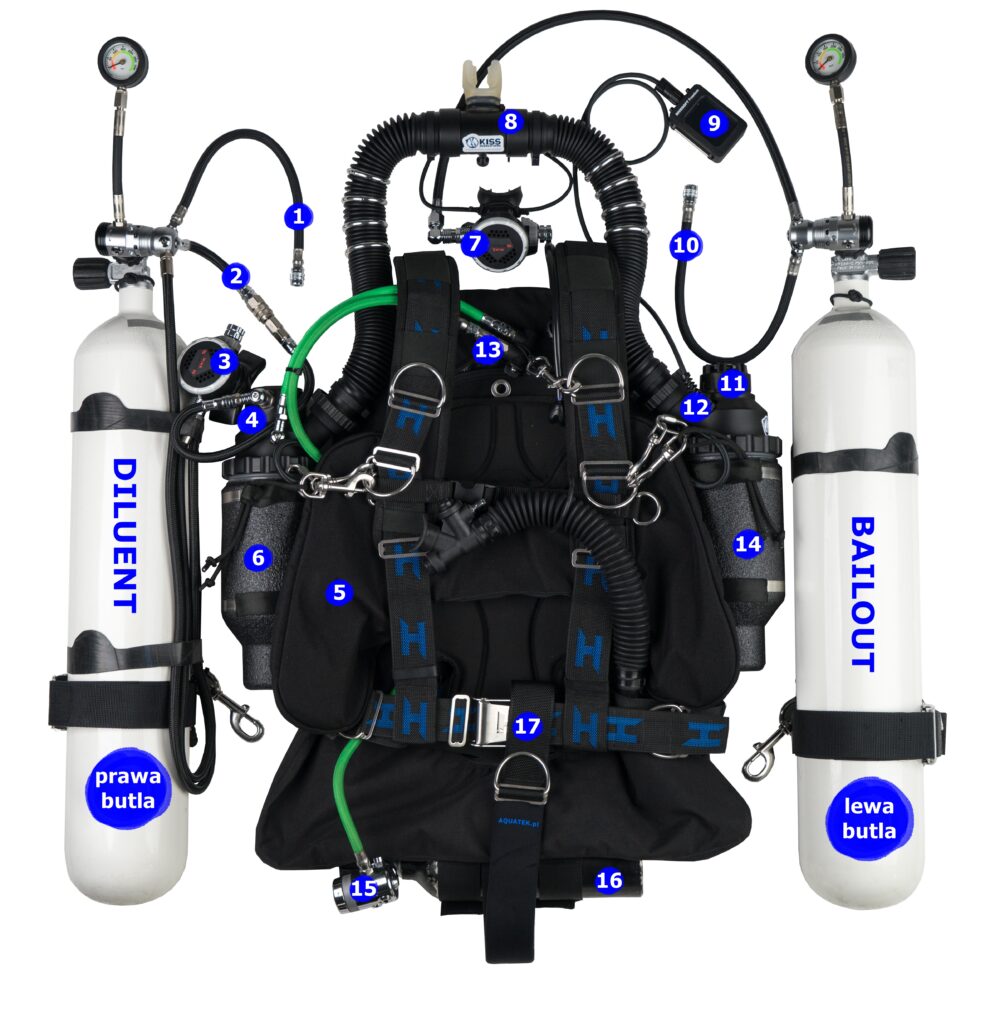KISS Rebreathers: A Unique Philosophy
For over two decades, KISS Rebreathers has been at the forefront of rebreather innovation, following the "Keep It Simple" principle. Their design philosophy emphasizes simplicity, reliability, and ease of maintenance—critical factors for life-support equipment used in underwater exploration. This philosophy has been perfectly embodied in the KISS Sidewinder, a groundbreaking rebreather specifically designed for sidemount diving.
A Breakthrough in Sidemount Diving
The KISS Sidewinder is the only rebreather on the market that allows divers to maintain a traditional sidemount configuration without increasing their underwater profile. Its innovative design splits the CO₂ scrubber canisters on either side of the diver, ensuring maximum hydrodynamics and comfort. This means that divers can enjoy the numerous benefits of a closed-circuit rebreather (CCR) without compromising mobility, streamlining, or convenience.
How Do Rebreathers Work?
Rebreathers, like the KISS Sidewinder, operate by performing three essential functions:
- Recycling Unused Gas – Unlike open-circuit systems that release exhaled gas into the water, rebreathers recirculate and filter it, significantly reducing gas consumption and eliminating bubble trails.
- Scrubbing Exhaled Air – Exhaled air contains CO₂, which is removed by a scrubber, ensuring that the breathing gas remains safe and breathable.
- Oxygen Monitoring – Rebreathers automatically introduce oxygen into the breathing loop to maintain optimal gas composition, ensuring safe decompression and extended dive times.
The Origin of the KISS Sidewinder
The development of the KISS Sidewinder was driven by Joshua Hotaling, a Marine Corps veteran and technical diving enthusiast. Hotaling preferred sidemount diving and sought a rebreather that would meet his specific needs. Recognizing this demand, Mike Young, owner of KISS Rebreathers, designed the Sidewinder. The first prototype quickly gained recognition, leading to the official release of a revolutionary sidemount rebreather that set new industry standards.
Design and Functionality
The KISS Sidewinder features a dual scrubber design, optimizing efficiency and streamlining the diver’s profile.
- Right Canister – Contains connections for oxygen and diluent hoses, along with an automatic diluent addition valve (ADV).
- Left Canister – Houses three oxygen sensors and an overpressure valve. PPO₂ monitoring is managed using dive computers such as Shearwater or Divesoft.
- Counterlung Placement – Located between the diver’s back and sidemount harness, reducing drag and enhancing hydrodynamics.
Technical Specifications
- Maximum Depth: 91 meters
- CO₂ Scrubber Capacity: Approximately 2.2 kg, allowing for 4 hours of diving
- Compatibility: Fits most sidemount harnesses and tanks
- Canister Insulation: Optional insulation available for cold-water diving, improving efficiency by up to 20%
The Future: KISS Sidewinder 2
KISS Rebreathers is currently developing the next generation of their sidemount rebreather—the KISS Sidewinder 2. This new unit promises significant improvements over its predecessor, focusing on enhanced efficiency and ease of use.
Key Enhancements:
- Redesigned Scrubber System: The new design will improve CO₂ removal efficiency, ensuring an even cleaner breathing gas.
- Lower Breathing Effort: The upgraded scrubber design will require less breathing resistance from the diver, reducing exertion and improving comfort.
- Increased Scrubber Capacity: More absorbent material will allow for longer dive times without the need for frequent changes.
These advancements will make the KISS Sidewinder 2 an even more attractive option for technical and cave divers seeking a streamlined, high-performance sidemount rebreather.
Conclusion
The KISS Sidewinder represents a major step forward in rebreather technology, combining simplicity, reliability, and innovative engineering to create an ideal tool for sidemount divers. With the upcoming release of the KISS Sidewinder 2, divers can look forward to even greater efficiency, longer dive times, and improved ease of breathing. Whether exploring deep wrecks, navigating intricate cave systems, or simply seeking the advantages of a CCR, the Sidewinder continues to set the standard for sidemount rebreathers.

